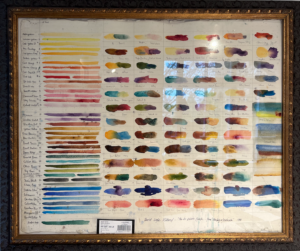Watercolor is a wonderful medium because of its freshness, transparency, spontaneity, movement, and vibrancy. Those characteristics depend upon the movement of water which quickly evaporates and leaves behind permanent pigment on the paper. The best watercolorists anticipate the movement of the water both while painting, as well as after drying when brush stokes and color will slightly change. It is a very quick and frustrating medium, as one unintended stroke can ruin a painting. There is no ‘do-over’ or ‘paint-over’ in watercolor which creates both the freshness and the frustration!
We often hear that watercolor paintings fade, but the oldest paintings in the world, cave paintings, are actually watercolors made with the most primitive of materials. Now watercolors (and beginning in the 19th century) are primarily on paper so the quality of the paper is critical as to the permanence of the painting.
There are basically four factors which determine the permanence of a watercolor: Paper, Pigment, Framing, and Light Exposure.
If a watercolor painted today is to be preserved for decades, it’s imperative that the paper and pigment used are of the best archival quality. These materials have greatly improved over the years due to an increased understanding of technology and chemistry.
Paper:
Acid-free paper made from 100% rag fiber (cotton, linen, etc.) can last forever if properly cared for and generally 140 lb cold-pressed paper has enough texture and weight to prevent buckling when stretched. The most expensive paper is 300-400# rough texture 100% acid-free rag paper however, it may be too stiff or textured for some watercolors.
For more information on paper, click HERE.
Permanence (via Wikipedia)
…the best art papers are designated archival, meaning they will last without significant deterioration for a century or more. Archival means that the papers are made entirely of high alpha cellulose or 100% cotton or linen fiber (that is, they are lignin free, as lignin causes darkening and embrittlement under light exposure), pH neutral (meaning there is no residual acidity left from the chemical processing of the pulp), buffered (a small quantity of an alkaline compound, usually calcium carbonate, is added to the furnish to neutralize the effect of atmospheric acids), and free of any artificial paper brighteners or whiteners (e.g., ultraviolet dyes). The content designations “100% cotton” or “100% cotton rag” have little significance to the actual quality or handling attributes of the paper. (A wide range of papers using alternative plant fibers, some of them not archival, are available from Asian manufacturers; some watercolor painters even employ sheets of printable plastic, sold under brand names such as Yupo.) Yupo is a synthetic paper that has that has a high ph value and works well with all watermedia paint

Bob keeps this framed color palette chart that he created on the wall next to him and refers to it for mixing colors.
Pigment:
The pigments used are as important as the acid-free paper. Lower-quality or student-grade watercolors are sold in sets without replacement cakes or tubes, and will generally not have lightfastness ratings. Student grade watercolors are usually made of dyes rather than permanent pigments and are somewhat less soluble; professional grade pans or tubes are very permanent and dissolve instantly at the touch of a wet brush. Some manufacturers grade their watercolors based on lightfastness ratings. Obviously, the better the materials, the more permanent the painting.
HERE is a resource on pigments
“The lead-bearing pigments that are approved for use in oils–flake white and Naples yellow–are not used in watercolor because of their susceptibility to turning dark on exposure to impure air when not protected by oil or varnish, their likelihood of reacting with other pigments when used in the gum-water mediums, and their poor brushing qualities in water mixtures”
[Mayer, Ralph. The Painter’s Craft. An Introduction to Artist’s Methods and Materials. Revised and updated by Steven Sheehan, Director of the Ralph Mayer Center, Yale University School of Art. New York: Penquin Group. 1948. 1991.]
In transparent watercolor [aquarelle], qouache, and unvarnished egg yolk tempera techniques, the pigments are bound in comparatively thin films to paper, cardboard, or a prepared wood panel by solutions of gum arabic, animal glues, or egg yolk. The paints are thinned with water. Because these binders do not encase the pigments so completely in a glassy film as is the case in the oil technique, the pigments used in the water techniques are more vulnerable to the effects of sunlight and the atmosphere.Thus pigments used in water techniques should be as resistant as possible to the chemical effects of acid- and sulfur-carrying gases, which are present in city atmosphere, and to the bleaching effect of light. [p. 5]
Sunlight & Framing:
[Kay, Reed. The Painters Guide to Studio Methods and Materials. Englewood Cliffs, NJ: Prentice-Hall, Inc., 1983.]
Exposure to Light and Appropriate Framing:
Finally, exposure to direct sunlight can be the most damaging environmental factor for watercolors. Framing must use acid-free mats. Additional information regarding appropriate framing for watercolors along with other helpful information can be found HERE